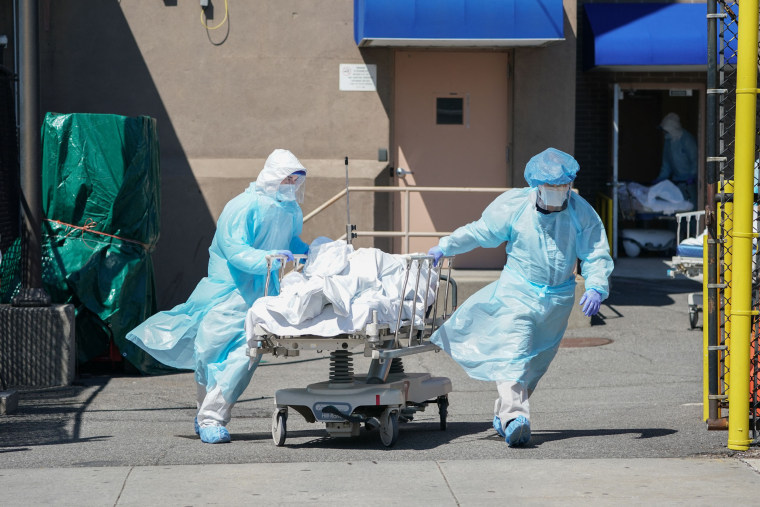Covid death rates are higher among Republicans than Democrats, mounting evidence shows

Bodies are moved to a refrigeration truck serving as a temporary morgue at Wyckoff Hospital in Brooklyn, N.Y., on April 6, 2020.Bryan R. Sith / AFP via Getty Images
Covid deaths are unevenly distributed among Republicans and Democrats.
Average excess death rates in Florida and Ohio were 76% higher among Republicans than Democrats from March 2020 to December 2021, according to a working paper released last month by the National Bureau of Economic Research. Excess deaths refers to deaths above what would be anticipated based on historical trends.
A study in June published in Health Affairs similarly found that counties with a Republican majority had a greater share of Covid deaths through October 2021, relative to majority-Democratic counties.
But experts are still puzzling over why these differences exist. Are lower vaccination rates among Republicans responsible? Or did mask use and social distancing guidelines prevent more deaths in counties run by Democrats?
The Yale researchers behind the new working paper say vaccine hesitancy among Republicans may be the biggest culprit.
"In counties where a large share of the population is getting vaccinated, we see a much smaller gap between Republicans and Democrats," said Jacob Wallace, an author of that study and an assistant professor of health policy at the Yale School of Public Health.
Indeed, his paper found that the partisan gap in the deaths widened from April to December 2021, after all adults became eligible for Covid vaccines. Excess death rates in Florida and Ohio were 153% higher among Republicans than Democrats during that time, the paper showed.
"We really don’t see a big divide until after vaccines became widely available in our two states," Wallace said.
But the June study suggested that Covid vaccine uptake explained just 10% of the partisan gap in the deaths. Those researchers suggested that compliance with other public health measures such as mask use and social distancing was a significant factor.
"Vaccination does play a role in the difference that we’ve observed in excess mortality between red and blue places, but it is not the whole story," said Neil Jay Sehgal, an author of that study and an assistant professor of health policy and management at the University of Maryland School of Public Health.
"When you have less transmission, you have fewer cases and you have less mortality. And you have less transmission in general by instituting protective policies like mask requirements when we had them, or capacity limits in businesses," he added.
Role of vaccine hesitancy
Both papers come with limitations. The study from Sehgal’s team looked at counties, not individuals, which makes it difficult to determine whether other demographic factors — such as education level, proximity to health care services or the share of older residents — played a role in the trend.
The new Yale paper, by contrast, linked political affiliation to excess Covid deaths at the individual level, but it still used county-level vaccination rates. The research was also limited to two states.
"It may very well be that in Ohio and Florida, because of the nature of Ohioans and Floridians, vaccine uptake may have played a greater role than the country at large," Sehgal said.
Wallace, however, said it's common knowledge that attitudes toward vaccines "are not Ohio- and Florida-specific issues."
Joe Gerald, an associate professor of public health policy and management at the University of Arizona, who was not involved in either study, agreed that Ohio and Florida are good places to study this issue, because "you have lots and lots of people that are otherwise very similar — they live in the same place, they’re roughly the same age distribution — but they differ by party ID."
He said he thinks vaccine uptake rates partly explain the gap in deaths, but it's still not clear how much they're to blame.
Will the partisan gap narrow?
Both Wallace and Sehgal said their studies shouldn't be misinterpreted as blaming Republicans for Covid deaths.
"This is not saying: If Republicans were in fact Democrats, they’d be less likely to die," Wallace said.
He added, however, that when it comes to the overall consequences of vaccine hesitancy, "we’re talking about a lot of preventable death and morbidity."
Around 20% of the U.S. population still hasn’t received a single Covid shot, according to the Centers for Disease Control and Prevention.
Gerald predicted that the partisan gap in Covid deaths could narrow over time as more people get Covid and acquire immunity, regardless of their vaccination status.
But Wallace cautioned that low vaccination rates might perpetuate the trend.
"Sadly, if the pandemic continues, and those vaccine attitude differences continue, we may continue to see this kind of a divide," he said.

No comments:
Post a Comment
Note: Only a member of this blog may post a comment.